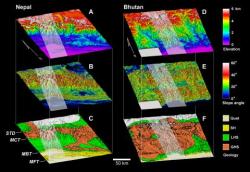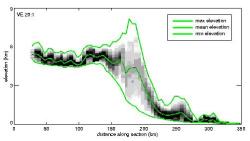Terrain: Surfaces & SwathsWe use off-the-shelf and custom GIS and remote sensing software to examine and compare various surface features - elevation (top), hillslopes (middle), and surface geology (bottom) - at two different locations in the Himalayan mountains. Standard tools allow us to paint the 3-dimensional topographic surface with colors taken from any other data source, such as slope angle, bedrock type, or satellite imagery (not shown). We separate these different views vertically while maintaining their map registration to aid in qualitative analysis.We use our own custom software to generate swath profiles of surface values such as elevation (below). The path of the swath is shown in as a lighter-colored band crossing the surfaces above. All values within the swath are projected onto the vertical plane running down the center of the swath, giving a much more informative type of cross section than a simple transect, which may miss important features that are just off the transect line. Our swath profiles give maximum, mean, and minimum values along the section within the swath, as well as density (frequency) plots of the values (greyscale checkerboard in the background). Input data can be points or rasters, and swaths can be single or multiple polylines. |


